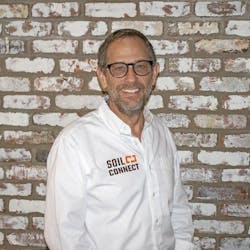Soil Connect Is Moving Dirt and Building Relationships
Soil Connect is one of those practical businesses that just makes so much sense, you wonder why it wasn’t started sooner. Created by third-generation builder and developer Cliff Fetner, Soil Connect simplifies the process of recycling and relocating excavated dirt and other aggregates commonly wasted in the land development and building process.
The start-up’s online aspect is as simple (and brilliant) as its business model: search, click, and request to send or receive materials to or from a jobsite with live tracking and updates—a platform that earned Fetner first place in the Design+Build category at the 2023 Housing Innovation Summit’s Pitchfest competition. Soil Connect also enables a network for home builders, developers, trade workers, and even those outside of the industry to connect, communicate, and find resources that extend far beyond just moving soil.
PRO BUILDER: When did you first notice the need for a better system for moving dirt?
Cliff Fetner: I began working in the building industry with a family business in metro New York [City], and after several years, I started my own venture developing properties in Brooklyn. I broke ground on a project in 2018 and ended up with a pile of dirt I couldn’t get rid of. I realized not only that it was a common problem among builders and developers, but it also presented an opportunity for a new resource for people in the industry.
PB: How does Soil Connect work?
CF: Our platform works like Airbnb, in a sense. You can sign up for free, and once you’re a registered user, you have access to active sites in your local marketplace with pinned locations, all looking to receive or get rid of dirt or other aggregates.
We have 22 different types of dirt, from compost and mulch to recycled concrete, and we match people looking to get rid of those aggregates with other users who need them. Once users match, they can communicate through the app.
RELATED
- Arx’s Approach to Underwriting Deals With AI
- John Green’s Plan to Eliminate Predatory Lending Practices
- Introducing Modular Construction to a New Labor Force
PB: Apart from just moving dirt, what other resources does Soil Connect provide to users?
CF: One of the most significant things we do is create closer connections by putting everyone in the dirt ecosystem in one place at one time. Home builders hang out with home builders, and Soil Connect brings them together. A user can look at their map through our app and see where other builders or developers are located and what projects they’re working on.
But it’s not just home builders. We’re currently approaching 1,000 users, and that also includes general contractors, developers, dump truck drivers, landscapers, pool contractors, farmers, and ranchers.
Now people who may otherwise never meet are being put in the same sphere to connect with one another. That kind of efficiency and connectivity has never existed before in this industry.
Not only are we recycling dirt, but we’re recycling concrete, which has one of the most substantial carbon footprints in the industry.
PB: Can you speak to the environmental impact of recycling dirt and aggregates?
CF: Not only are we recycling dirt, but we’re recycling concrete, which has one of the most substantial carbon footprints in the industry. On infill sites, for example, contractors are crushing concrete, putting it on our platform, and recycling it by selling it to others who can use it. The same can be said for other materials. We’re making it easier for builders to recycle.
In addition, instead of being forced to drive dozens of miles to dump those aggregates, people using our platform can find someone closer who actually needs them. In that sense, Soil Connect is saving money, time, gas, and, in turn, is helping the environment.
PB: Is this also a more cost-effective solution for developers?
CF: Definitely. A case study we conducted with ARCO/Murray Construction revealed that we helped them save $185K on a project in North Texas. Before our involvement, the estimated cost to move 21,000 cubic yards [CY] of common fill clay was over $400K, with a time frame of more than eight to nine weeks.
We ultimately stepped in and helped ARCO/Murray Construction remove 21,000 CY of wet clay in 1,615 loads over a four-week period. That saved the company an average of $115 per CY load, and it also had a major environmental impact. We calculated that total miles traveled was reduced by more than 58,000, which, in turn, saved more than 11,000 gallons of diesel fuel and reduced CO2 emission by 130.2 tons.
PB: What’s next for Soil Connect?
CF: I see an ability to create even more connections in the industry through AI [artificial intelligence]. I want to become a one-stop shop for any and all dirt needs, and above all, I want to make things simple for our users. That means employing a live tracking geofence to keep an eye on trucks for a fast, easy way to track the entire process of relocating aggregates.
We’re also using e-ticketing to help users finalize transactions and get paid faster. That can take some time to integrate among drivers who aren’t familiar with that kind of technology, so we’re also working to train and onboard those users to get them set up with that system.
Soil Connect won its category of the first annual “Pitchfest” at the 2023 Innovation Summit hosted by the Housing Innovation Alliance.


